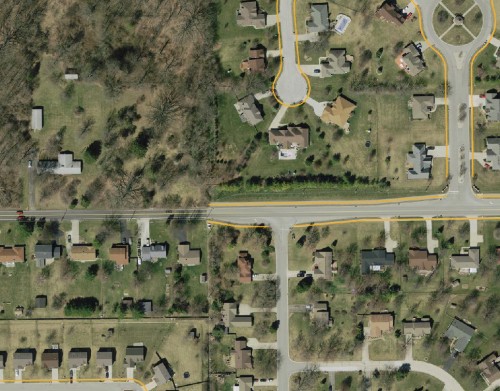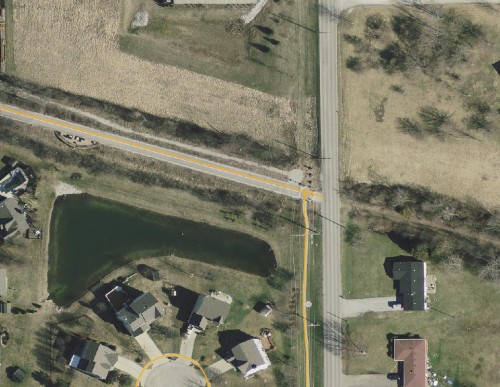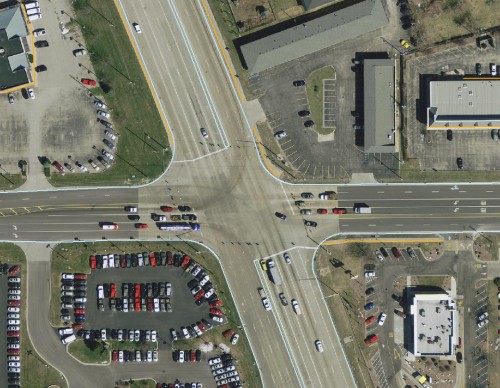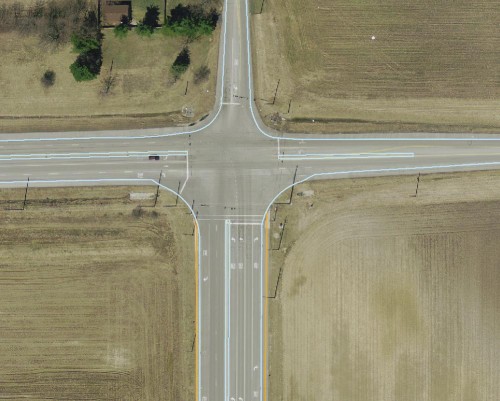The suburban doughnut counties have had a long reputation as an area that is hospitable to vehicular traffic, and not much else. Â Carmel has been fighting that reputation for decades now, but how are the other areas in the region faring? In some instances, better than Marion County.
Let’s look at one example from each of the four major borders that Marion County has. Â First up, Hendricks County:
The slightly angled paved stretch marked in orange is the B & O Trail. A small portion of the trail has been completed towards Raceway Road, where it stops abruptly. Indianapolis is not planning on extending the trail within the next 2 years.
Another interesting case exists on the city’s eastern border with Hancock County:

The county border is not marked by a road here, but it is still obvious to see where it is exists. Hancock County has built a sidewalk along 21st Street right up to the border.
A less glaring example of a sidewalk disconnection exists up in Hamilton County at the intersection of Michigan and 96th Street:
This intersection would be dangerous for pedestrians even if Marion County had sidewalks on their portion. It would take some major re-configuration for this area to be considered safe for all modes of travel.
Finally, Johnson County takes things the other direction at Arlington and County Line Road:
A road that was over-built to accommodate businesses and traffic that has yet to come. But, they did at least include a sidewalk, where in Marion County the street still looks like an old county road.
These are not the only examples of this curious development pattern to exist along the county borders, but I do believe there are more of these examples than there are of sidewalks existing within Marion County and stopping right at the border. And 2 of our longer multi-use trails, the Monon and Pennsy, extend out past the boundary.
It appears the doughnut counties are listening to the citizens about providing safe means of travel by foot. Likewise, I know Indianapolis is listening as well. But we obviously have a long way to go towards putting words in to action, and connecting people to places.



It’s quite amazing how much the small Hendricks Co B&O group has been able to accomplish through mostly grassroots efforts.
The Michigan Rd. one is particularly egregious. That was all one project. Zionsville and Carmel demanded sidewalks. Indy demanded nothing. So the state dropped the sidewalks at 96th and even converted from enclosed drainage to open ditches. That shows exactly what the state really thinks of transport infrastructure.
Counter examples: East Washington. Sidewalk both sides from Downtown to Irvington, then runs on one side or the other through interchanges at Shadeland and 465 and on both sides east of Franklin all the way to South Carroll Road…the eastern edge of Marion County. Then it stops.
Likewise Pendleton Pike. Sidewalk from I-465 through Lawrence dies out just over the Hancock border in McCordsville.
Both are state roads. So INDOT can be persuaded.
I doubt Hancock County built that sidewalk. Both those neighborhoods are within the municipal borders of the Town of Cumberland. Cumberland has done really well in this area, with a redesigned US40/Washington St. in the older part of the town, as well as building a pedestrian/bike path along the Pennsy trail along their entire municipal area. Cumberland is planning an annexation, or at least was. I haven’t heard much more on that. Many people will fight it because of what is happening with municipal sewer and water rates, plus the initial hook-up fees can be costly.
This is my personal opinion after living in Indy for 13 years now. Marion county is much too large and this is a large part of the problem for building adequate infrastructure of all kinds. How can one centralized DPW handle 372 sq miles of roads, proper drainage, side walks, trails, lights, etc? It just can’t, especially in a city like Indy which generally abhors spending money if it really feels like it doesn’t have to. I truly believe that more responsibility for maintaining the infrastructure should be divided up to many more localities around Marion county. This would make many more grassroot efforts possible. Could you imagine if a place like Broad Ripple didn’t have to get down town’s approval to install and maintain the type of infrastructure that it needs or wants that’s unique to that area? Unigov was a horrible idea for the responsiveness and accessibility of the local city government.
I got ninja’d! Good post.
Agreed. Jim, ahow628, great comments here today.
I don’t think Indianapolis is too large. LA covers 502.7 square miles, Phoenix covers 516.7 square miles and Houston covers a whopping 627.8 square miles, all much larger than the area of Indianapolis. Size is not really the issue, what is the issue is the “let’s do everything on the cheap” mentality that runs through local government, which is encouraged by the historic resistance of residents to disapprove of tax increases to pay for improved city services (though this attitude is changing, especially among younger residents).
As for Unigov, I seriously doubt you would have the downtown you have today in Indianapolis if it weren’t for Unigov. Indianapolis would be a smaller, less important, and more rundown city, and the downtown would be much less polished or interesting. Also, you probably would not have many of the other big public works projects, like the shiny new airport, etc. Unigov bought the city many decades of time to address systemic issues by effectively bringing the suburbs into the city limits. Unfortunately, that time is beginning to run out, as the suburbs have jumped to the outer ring counties.
Also, you don’t seem to understand your local history, Broad Ripple became part of Indianapolis many decades before Unigov ever passed, so with or without Unigov, Broad Ripple would still be a part of the City of Indianapolis. Though, even for the sake of playing “let’s pretend,” I do not think Broad Ripple would be anything special as a separate municipality; rather, it would just be a sleepy and aging suburb. Though, if you prefer a less developed and more working-class neighborhood, I suppose that might be a good thing. But, you would have all the associated challenges that go with being an old suburb.
In any event, regardless of whether Unigov was a “horrible idea” (which I emphatically think it was not) or a great idea, it most certainly is a DONE deal. We could debate the merits of what it would be like to have wings and live on a cloud planet called Vestar, but we would only be discussing a fantasy, much like debating the fantasy of an alternative reality where Unigov didn’t exist.
I would much rather deal with reality.
In the interest of fairness, I would point out that an “alternate reality” could have resulted in Broad Ripple annexing much more of what is now Meridian Kessler and Butler Tarkington and remaining independent. (It had only gobbled as far south as about 52nd & College and as far west as Central prior to being absorbed into Indianapolis).
BR could well have become something like Bexley, Ohio…a well-to-do, independent streetcar suburb that has gotten even more well-to-do over the years because its independent school system is very highly regarded. Physically, Bexley is very similar (mostly gridded streets with a mansion section); it also has a small university and the governor’s mansion. I assure you, it is not crumbling.
Had it done so, like Speedway, Lawrence, Southport, and Beech Grove, it could have stayed out of Unigov (though one might argue that the “excluded cities” get the worst of Unigov’s deal). This is indeed “alternate reality” but it doesn’t involve 10-foot blue creatures.
Chris, do you mean in an alternate reality before Unigov ever existed? As mentioned, Broad Ripple was part of Indianapolis for decades before Unigov passed into law. It would have been impossible for Broad Ripple to have annexed Meridian Kessler since both areas were already part of Indianapolis long before Unigov was even dreamed of.
I am not sure how Bexley, Ohio is relevant to anthing being discussed here, unless we are really going to play fast and loose with our fantasy history and imagine somehow that Broad Ripple could have combined with Meridian Kessler and Butler Tarkington (also, another neighborhood that was long part of Indianapolis before Unigov was even imagined).
If we are going down that path, then in an alternate reality, Irvington could have annexed land over into Hancock County and grown into a big city. Or, West Indianapolis (look that one up) could still be a booming industrial town today.
I don’t think there is any harm in “what if,” but I don’t see how it is more than a fun little imagination exercise.
Moreover, do you want to live in a city, or in an area of neighboring little towns?
You and Jim seem to be arguing for a vision of breaking up Indianapolis into a bunch of small towns. That is all well and good, but then you would no longer have a city, you would just have a bunch of little towns.
And, if you had that breakup occur in some fantasy past, there is no guarantee, and in fact it is highly unlikely, all these little towns would even vaguely resemble a “real city.” It’s possible if some of the towns grew large enough you might have something resembling the Quad Cities (which has a regional population considerably smaller than even just Indianapolis proper), but it’s likely you wouldn’t even get something on that scale. Also, even if you kept some version of a capital city called Indianapolis, surrounded by a bunch of little towns, it doesn’t mean it would have to be very big, e.g. ever been to Jefferson City, MO?
No, I prefer to live in a real city, not a bunch of old subdivisions (no matter how pretty) strung together.
You raised the “history” issue. There was a bit of a race between Indy and BR to gobble up what is now MK and BT. BR threw in the towel…but what if it hadn’t? You seemed to be arguing that it would have turned into a forgotten backwater. I think it would probably look a lot like Bexley, Ohio…which is a good thing. Those streetcar suburban “subdivisions” are considered “urban” today.
I was also making a “devil’s advocate” argument, to bring focus on the Marion County excluded cities that stayed independent as a way of understanding the positives and negatives of Unigov.
Columbus, Ohio does not have Unigov, and its metro is about the same as Indy in size and significance. Several suburban enclaves exist, not unlike the Marion County “excluded cities”. Bexley is one; Upper Arlington, Worthington, Whitehall are the others. Some are good, and some are bad. Staying independent of the big city is not in itself a good or bad thing.
There really was not much of a race. Most of what is Meridian Kessler was annexted by Indianapolis in 1905. Broad Ripple was annexed in 1922. It would have been impossible for Broad Ripple to annex most of Meridian Kessler because it was already part of Indianapolis. Much of the current character of Broad Ripple was built following the annexation to Indianapolis. Yes, there are still existing pre-annexation buildings, but quite a lot was built after 1922.
As for Columbus, Ohio, while it doesn’t have Unigov, it does cover 223 square miles, which is hardly the sort of collection of small municipalities you seem to argue for, and much of the growth by Columbus has occured through annexation.
Mind you, I am not trying to argue, I’m just having fun debating, but I do disagree with the premise that Unigov was harmful, or that Indianapolis would have been better off without it.
To be more clear on your query: I subscribe in part to Aaron Renn’s “100 Monument Circles” vision of Indianapolis as a polycentric community.
By that, I mean that the little village cores and nodes that exist around the City-County are things of value that should be highlighted for preservation and redevelopment. They are assets to build on. I’m thinking of Irvington, Broad Ripple, Nora, Fort Harrison, New Augusta, East 10th, even something as compact as 56th & Illinois.
But other than the existing excluded cities, I am not sure about creating some intermediate “area” governance structure with formal powers to determine public investment.
I’m okay with community-based planning efforts becoming “area plans” that guide city investment. I don’t think we need “local councils” or formal structures at a level lower than combined city-county government.
Chris, I agree with Aaron’s theory, too, and in fact, I have been a bigger promoter of it.
But, his theory of preserving and protecting “village” nodes does not require having actual separate muncipalities. You can have strong communities and good neighborhood character and still have one unified city.
We agree.
There is a very different dynamic going on for Marion County vs the donut counties. Marion county is most dense at its core and pretty good sidewalk coverage (if not design, ugh) in the central 100 square miles or so (out of 400sqmi). It has focused far less energy on the lighter populated edges.
However, jump from Marion to a donut that shares an entire border and the densest part is the 100 or so square miles directly along the border. For corner donuts, it’s probably 25sqmi or so.
I had pointed out here a month or two ago that I personally think Unigov seemed like a short-term solution, but in the long-term will end up being a mistake. I think this is an example. People think of the edges of Marion County as Indianapolis, but in reality, it is just “Indianapolis” aka rural Marion County.
Incidentally, the residents there want the same infrastructure (sidewalks, sewers, city water, roads) as Indy has in Center Township. If they were living in Marion County, I doubt they would be make such demands and I doubt that this article would have ever been written.
Putting this in a new thread since that prior one was getting overly nested.
Chris, I agree with Aaron’s theory, too, and in fact, I have been a bigger promoter of it. But, his theory of preserving and protecting “village†nodes does not require having actual separate muncipalities. You can have strong communities and good neighborhood character and still have one unified city.
The biggest problem I see, as I had mentioned before is the variation in “conservativeness” in the various areas. Downtown dwellers tend to want to spend money on nice infrastructure and don’t mind paying for it. The further you get from the core, the less people want to pay. With separate municipalities (or tax districts or whatever you want to call them), you would alleviate that problem.
Also, in terms of infrastructure, my downtown neighborhood has some of the oldest water lines in the city (I hear 1880s). Since the houses are all 5 feet apart and our blocks are small, replacing all the water pipes would be a fairly small project which would provide the benefit of nearly doubling our water pressure. Unfortunately all the water budget is spent running long lengths of pipe in the surrounding townships in new developments. On the positive side, the sewer rates are going to be going down pretty healthily for downtowners as they will charge based on non-permeable surface area (we don’t have driveways here, houses are two story) while township rates will go up (large driveways, single story ranch houses).
Sorry about the digression, but there are a ton of moving parts, and I feel like Unigov welded a number of those parts together that should have been free-moving and we are starting to see the stress fractures forming.
I don’t think it’s a digression. The original poster brought up his point of view as to one of the causes of the “where the sidewalk ends” syndrome you mention. It has made for an interesting debate.
However, I think the critics of Unigov have conflated different issues.
First, the “sidewalk cut off” issue focused on in the article dealt with inadequate infrastructure on the fringes of the county. However, you and other posters criticizing Unigov have focused on the perceived effect of Unigov on the core city’s infrastructure–the opposite of the issue brought up by this article. Also, the argument that Unigov supposedly siphons city resources away from the old city to the still growing outer county fringes ignores the fact that Unigov substantially increases the tax base and that tax revenue is fungible and spent countywide. In other words, much of the spending that occurs on downtown projects and infrastructure comes from tax revenue raised in other parts of the county.
Second, it seems there is confusion about what Unigov is and when it occured. Unigov was passed in 1970 and it merged the City of Indianapolis with the rest of the unicorporated surrounding county and several small municipalities, though a few larger municipalities were left substantially, though not completely, autonomous (Lawrence, Southport, Speedway, and Beech Grove are fairly independent, but they are still subject to county-wide ordinances passed by the City-County Council, and their laws may not conflict with county-wide ordinances). However, there were several posts arguing for an alternate reality of an independent Broad Ripple or Meridian Kessler, ignoring the fact that those areas where annexed by Indianapolis several decades before Unigov (48 years before and 64 years respectively), and those neighborhoods saw either all their growth occur post annexation or a substantial part of it (e.g. Meridian Kessler was mainly farms and a smattering of country estates when annexed). In short, the annexation of old farms and street-car suburbs in the very early 20th century has nothing to do with Unigov.
Third, I believe if anything, Unigov didn’t go far enough. The IPD and the Sherrif’s Department were finally merged decades after Unigov passed, while the fire department consolidation is still on-going. Far worse, was the omission of the school systems from consolidation. IPS was left to bleed out students while numerous and often duplicative township and municipal school districts were left intact (and now IPS sees its diminishing tax base further eaten away by charter-happy Mayor Ballard along with the TIF-happy City-County Council). For example, Northwest Highschool has a huge building complex that is greatly under capacity; meanwhile, Speedway has its own highschool only a mile away. Two entirely separate school campuses must be maintained to serve students living in the same area when the same sized student body could easily and comfortablely be served in one of the existing buildings and the uneeded campus could be sold off to raise much needed revenue for public education.